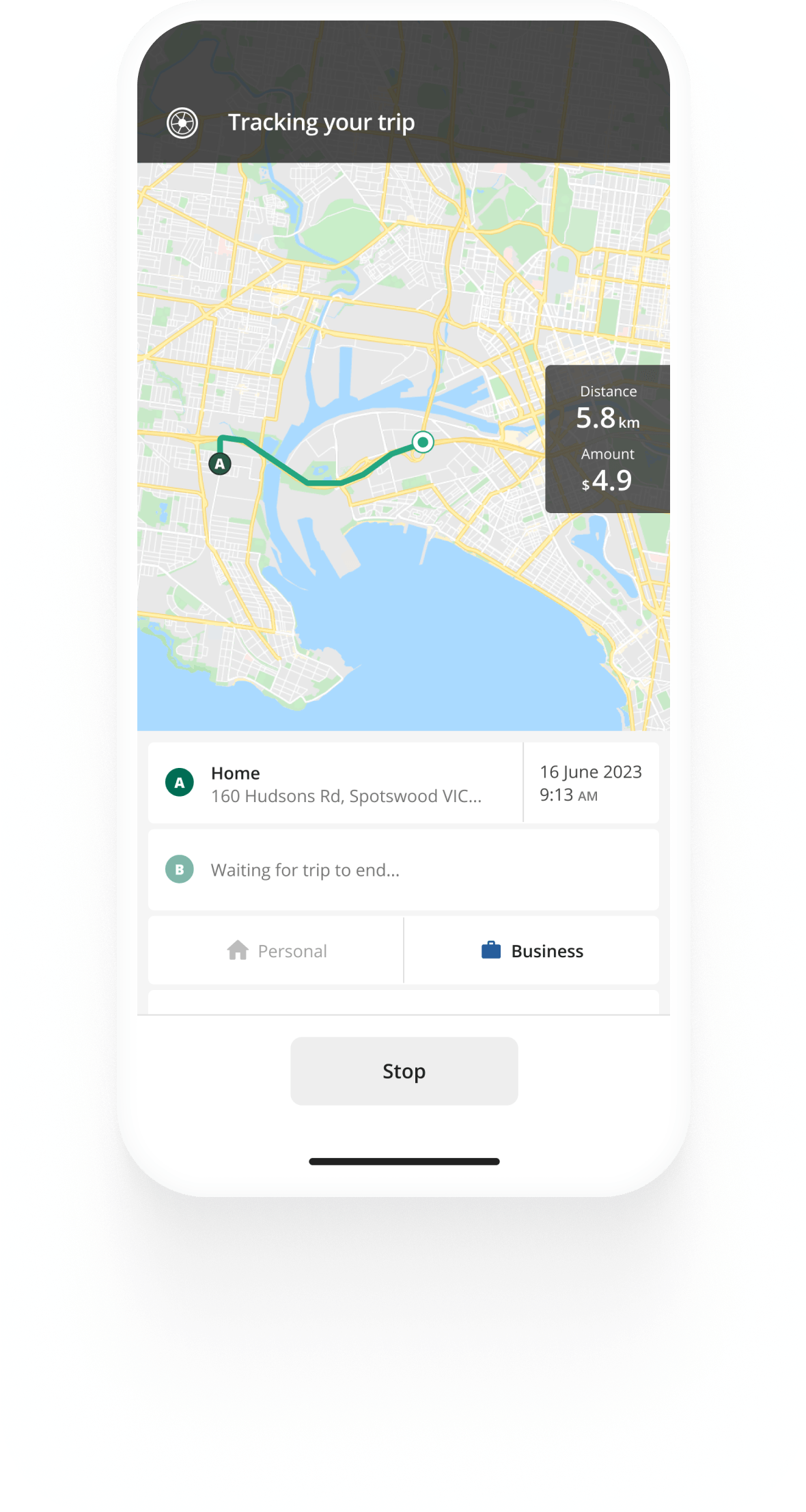Track mileage automatically
Get started
How To Keep a Car Log Book for Tax
You need to keep an ATO-compliant car log book that proves you have driven the kilometres for business purposes for which you claim a deduction.
The cents per km method
While the ATO doesn't require you to submit a car log book when you claim business kilometres using the cents per km method, they may later ask you to show how you worked out your claim. So, keep a log book with your trips, dates, distance and purpose.
The cents per kilometre method allows you to claim a fixed rate per business kilometre for up to 5,000 km annually.


Kilometre tracking made easy
Trusted by millions of drivers
Automate your logbook Automate your logbook

Automatic mileage tracking and ATO-compliant reporting.
Get started for free Get started for freeThe logbook method
If you use your car frequently for work, the logbook method will result in a larger tax deduction than the cents per kilometre method, as you can claim all actual expenses you had for running and maintaining your car.
Using the logbook method allows you to claim a percentage of all of your car expenses (fuel, registration, maintenance, interest on loans, etc.). If you drove your car for business purposes 60% of the time, you can claim 60% of all car expenses you had throughout the year.
Filling out your car log book for tax
With the logbook method, you can keep a car log book for three months in one tax year and use it as evidence of your business car expenses claim for the next five years, so long as your driving doesn't change much. If your driving changes, start a new log book.
You must record specific information to ensure your ATO car log book is compliant. Failing to do so could cost you your whole deduction claim.
For each trip, record:
- The start and end date of each journey
- the number of kilometres travelled for each journey
- the odometer readings of your vehicle at the start and end of each journey
- the reason for the journey
Add the following information to your logbook:
- the business-use percentage for the logbook period
- the vehicle's make, model, engine capacity, and registration number
- when the logbook period begins and ends
- the total number of kilometres you’ve driven during the logbook period
- the odometer readings of the car at the start and end of the logbook period
- the odometer readings at the beginning and end of each subsequent income year your logbook is valid for
You must log every trip you take in your car, not just work trips. If you fail to do so, the ATO will consider your logbook invalid and may reject all of your car expense claims.
Finally, if you use the logbook method to claim actual vehicle expenses, remember to keep all receipts and invoices for the expenses you’ve incurred throughout the year.
Is the logbook method time-consuming?
The logbook method may be time-consuming, depending on how many trips you take. Still, you can claim all actual expenses related to using your vehicle for business purposes.
However, using an app to log your trips will significantly reduce the time you spend maintaining your log book for tax purposes. You will only need to keep track of your receipts.
Log book formats for tax claims
The ATO accepts physical and digital log book formats as long as they prove your claim sufficiently. There's the physical log book, which you can purchase online or from various supply shops. Many people also use spreadsheets, Excel files, and PDF files as logs for tax purposes.
An automatic logbook app such as Driversnote helps you spend much less time logging trips and manually inputting data every time you drive. Then, you will only need to keep your car expense receipts on file.
How to calculate your tax claim with your log book
To determine how much you can claim using the logbook method, follow the steps below to calculate your reimbursement.
To begin with, make sure you are keeping an accurate log book.
- Calculate your business-use percentage by dividing the total distance travelled by the distance travelled for business and multiplying by 100.
- Sum up your car expenses for the fiscal year.
- Multiply your total car expenses by your percentage of business use.
If you claim your work kilometres through the cents per kilometre method, you still keep an ATO vehicle log book, but you don’t need to collect receipts for your car-related expenses. Simply multiply your business-related kilometres by the ATO’s cents per km rate.
Use our cents per km calculator to see how much you’ll be able to claim for your business-related driving with the cents per km method.
FAQ

Tired of logging mileage by hand?
Effortless. ATO-compliant. Liberating.
Latest posts
- Hiring Employees as a Sole Trader
- How to Write Off a Car for Business in Australia
- Employers' Guide to FBT-Exempt Benefits
Related posts
ATO Mileage Guide
25 June 2024 - 5 min read
Learn about the rules of reimbursing employees for their car expenses or deducting expenses as an employee or self-employed individual.
Hiring Employees as a Sole Trader
15 April 2025 - 5 min read
How to hire employees as a sole trader in Australia and the main obligations and considerations in doing so.
How to Write Off a Car for Business in Australia
15 April 2025 - 2 min read
Don't miss out on writing off a car for business - it may be the largest deduction you can claim as a business owner. See the 2024/25 ATO rules.

.svg)
.svg)